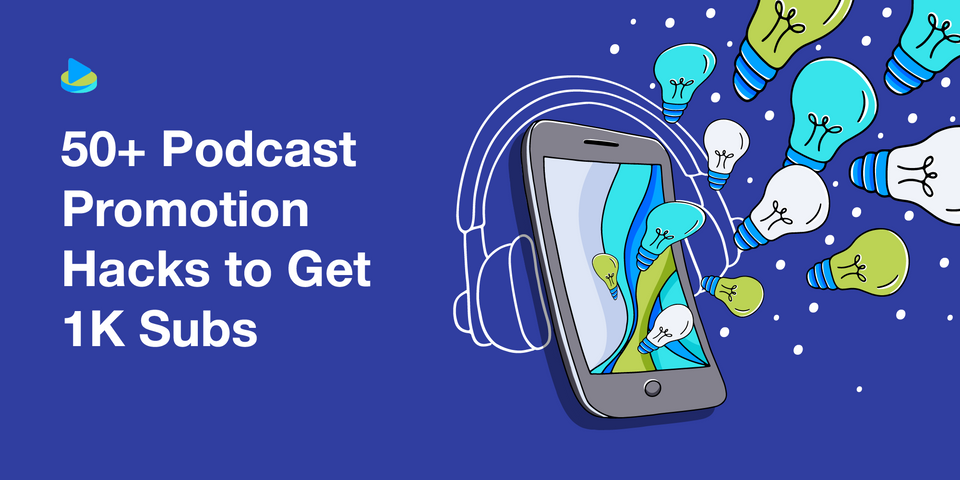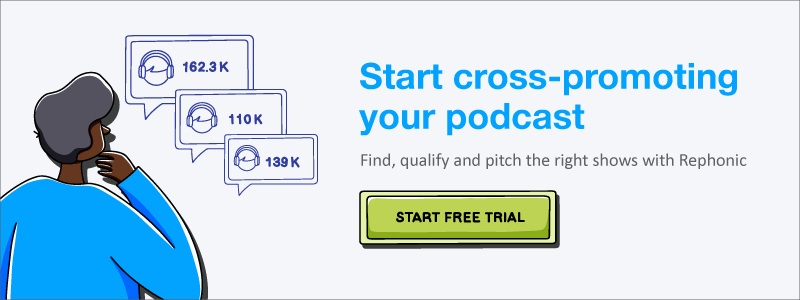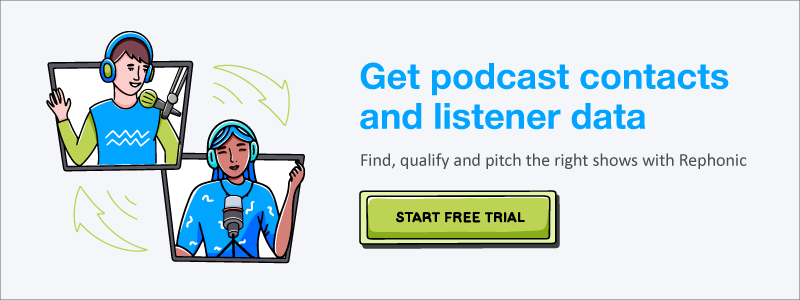How do I get my podcast noticed? That's a huge question when you're one of two million, all vying for attention. Because unfortunately, recording a top-quality show isn't enough anymore. You have to know how to promote a podcast, too.
There's a ton of advice on blogs, YouTube and podcasts, but you don't have time to search for all the answers. Don't worry; we've got your back!
We've found some of the best resources and linked them to them in this mammoth guide of 50+ podcast promotion tips. Let's get started on the next stage of your exciting podcasting journey.
Table of Contents
Get the basics right
#1 — Identify your target audience
There's no "one size fits all" in podcasting. Every podcast targets a particular group of people who are as passionate about that topic or niche as the podcaster is
When you understand your target audience, it's much easier to promote a podcast. You recognize the right words to use and what resonates with the audience. You know what sponsors and advertisers will appeal to them and what guests will add value.
You know what social media platforms they hang out on, what jokes they like, and the issues they face. Everything is easier when you're on the same page with your target audience.
Check out our in-depth article about finding a winning podcast niche, or head to Twitter for some podcast promotion tactics from Jeremy Enns.
#2 — Choose your category wisely
Categories help potential listeners find new podcasts by grouping shows under large primary niches.
Examples from Apple Podcasts include Arts, Education, Health, Kids & Family, and Business. Many are broken into sub-categories, too. So, in Apple podcasts, the Comedy category includes Comedy Interviews, Improv & Stand-Up, while Business is divided into Careers, Entrepreneurship, Investing, Management, Marketing, & Non-Profit.
You can list your podcast under more than one category and sub-category, but Search Engines mostly use the primary category.
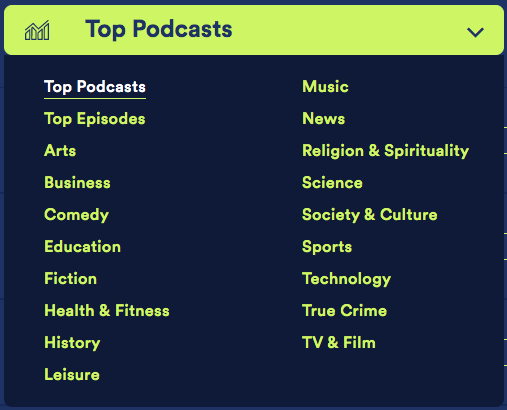
Here's what Apple has to say about listing primary and secondary categories and an informative article on choosing the best ones for your podcast.
#3 — Have a great title
As we explain in How To Make Your Podcast Go Viral, your podcast name MATTERS!
While it's tempting to be cute or clever with your podcast name, you also want to avoid any listener friction. In other words, don't make people think too hard - let them know what you're podcast is about right there in the title.
Podcast titles that tell it like it is:
"How Do I Grow That?" (Gardening category), "Decorating Tips and Tricks" (Interior Design), and "The Recipe for SEO Success." (SEO)
Examples of ambiguous podcast titles:
"Chat 10, Looks 3." (Society and Culture category), "Seriously..." (News), and "Conversations" (Relationships).
A noticeable name can work to your advantage once you have an audience, but it's harder to start if people don't immediately understand your podcast. Here's a fascinating insight into Jay Clouse's process for choosing a new brand name, to help you choose your podcast title.
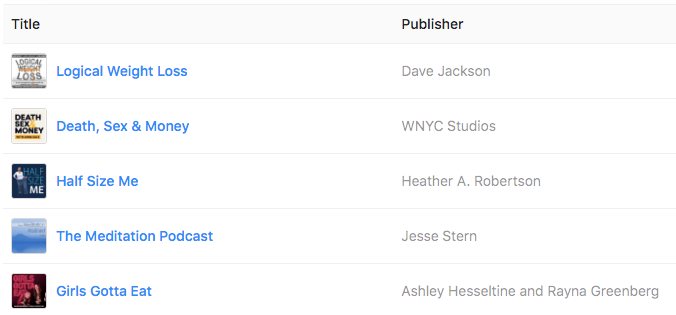
#4 — Have a clear, engaging show summary
If you choose a clever or ambiguous name, you must write a clear summary that hooks people in. Spell it out: what will they get out of listening to your podcast?
Some show notes say it all very succinctly. For example, The Desert Island Discs summary is short and sweet. "Eight tracks, a book and a luxury: what would you take to a desert island? Guests share the soundtrack of their lives."
However, Desert Island Classics explains its premise in more detail:

Here's some detailed advice on how to write a killer podcast description.
#5 — Create stand out cover art
There's a reason why we often do judge a book by its cover. Our eyes and brains are drawn to color and images. That's why your cover art could make a difference in attracting new listeners. Consider size, font, image, colors and clarity. Minimalist is preferable to 'cluttered' because your cover art needs to catch the eye and instantly communicate the essentials to your potential listeners.
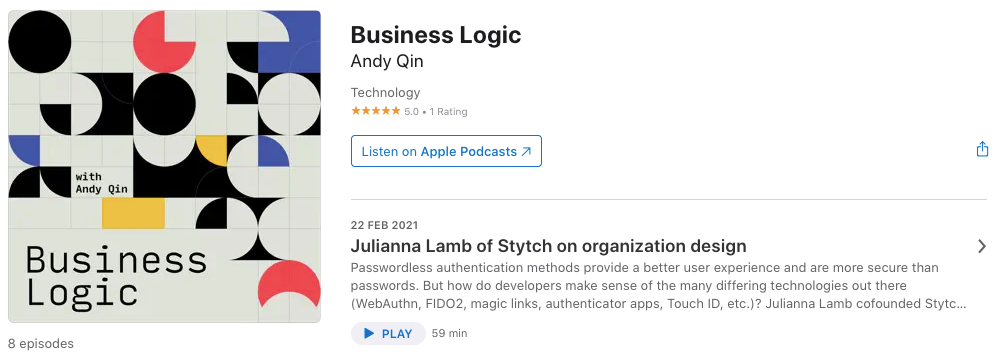
Want more information? Here's an excellent article from Blush Design that explains why and how to create great podcast cover art.
#6 — Submit to every podcast directory and app
Podcast directories are apps that make it easy to find and listen to podcasts. There are a mind-blowing number of podcast directories worldwide, and if you want people to discover your podcast, you need to submit it to many, if not all, of them.
Some directories are more popular than others - you've probably heard of Apple Podcasts, Spotify, Google Podcasts and Audible. Those are the biggest directories in the US and the UK. However, people in India often prefer apps like AAWAZ; in China, you'd use Ximalaya or Lizhi. Check out this Podnews list of most of the world's directories and this video, which explains what you need to do before submitting your podcast to them.
#7 — Build the buzz before you launch
Make a splash before you launch a new podcast.
First, create a podcast trailer, or teaser, to give potential listeners a sample in advance. Podcast trailers let people know what you'll deliver, when, why and how. They build anticipation and invite them to like or subscribe right away.
Plan some social media posts, talk about it on your blog, in your newsletter and everywhere else your potential listeners hang out. If you're already in contact with other podcasters, get them to mention your upcoming show - and perhaps even make a guest appearance.
In Launch a Successful Podcast, Pat Flynn advises to "Work backward from your launch date and determine the other dates that make sense to market and/or promote your podcast."
#8 — Release more than one episode when you first launch
Give people something to binge-listen right from the start. If listeners love your first episode, the chances are they won't want to wait a week for the next one.
Indeed, it's always wise to record several episodes ahead to keep up with your content schedule. Try and have at least six episodes pre-recorded and release three of them on launch day.
#9 — Make it part of your business ecosystem
How does your podcast fit into your overall ecosystem? Do you have a strategic plan to drive more potential customers to your business? Where does it fit in your marketing funnel? Or is this a side project you're doing for fun, with no apparent link to your business?
Josh Spector recently launched his new podcast "I Want To Know" and in episode one he discusses how and why it fits into his business.
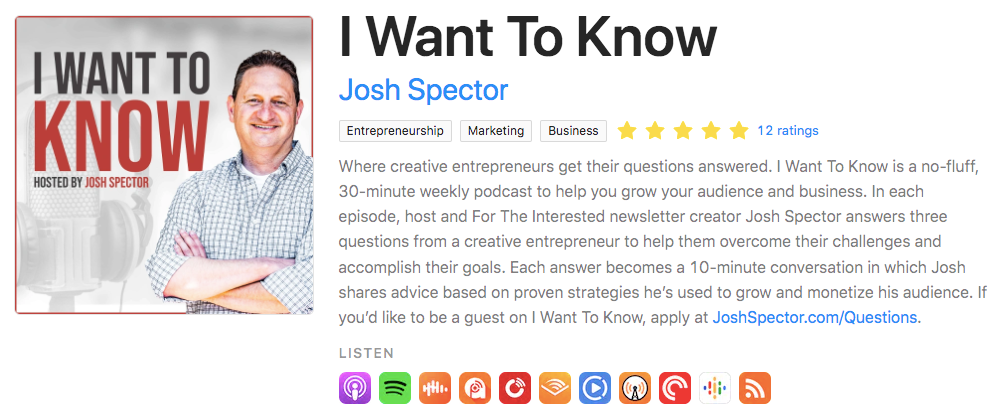
"I wanted to create a podcast that's not only a good standalone product... but also helps inspire new content ideas, product ideas... By recording one half-hour episode per week I get audio and visual content. That audio will go on Apple, Spotify, Podcast Addict and every place you listen to podcasts. The video will go on YouTube. Some of the clips can be repurposed on Twitter and LinkedIn..."
This podcast gives Josh new ways to connect with his audience and fits seamlessly into his newsletter and social media marketing strategies.
#10 — Add links in your email signature
Whether you send one email a week or ten a day, you can easily include a link to your podcast website at the end of every email.
Hyperlinks let people check out your show (or blog posts, YouTube videos, and social media platforms) quickly and easily. Of course, it's a different process for each email provider, so here's how to add a link in Gmail and Outlook.

#11 — Leverage existing channels
Don't ignore the channels you already have. Even a tiny following on LinkedIn, Instagram, and Facebook contains people who might be interested in your podcast content.
Podcast analytics are still way behind those of Google, YouTube and many social media channels, so it often makes sense to use those channels to build your audience and advertise the podcast there. Letting people in your existing channels know about your upcoming launch or the next podcast episode can be an effective way to start growing your audience. It's certainly better than trying to start marketing with zero contacts.
Think about podcast SEO
#12 — Do keyword research
Think about your SEO strategy. Make your podcast discoverable in podcast apps and search engines by adding keywords to your podcast episode titles, show notes, summaries and, of course, your podcast website.
Here's a tutorial from marketing expert and podcaster Neil Patel.
#13 — Create a podcast website
Your website is your podcast's internet home and a powerful way to take advantage of Search Engine Optimization.
A podcast website holds all the information and links associated with your podcast. That includes Your Story, episode show notes and transcripts, Patreon and Sponsorship links, and even merchandise if you've gone that far. (See #52). It's also an excellent place to promote your newsletter and social media channels. If you have podcast advertising, you can add links to sponsors and even tease future episodes.
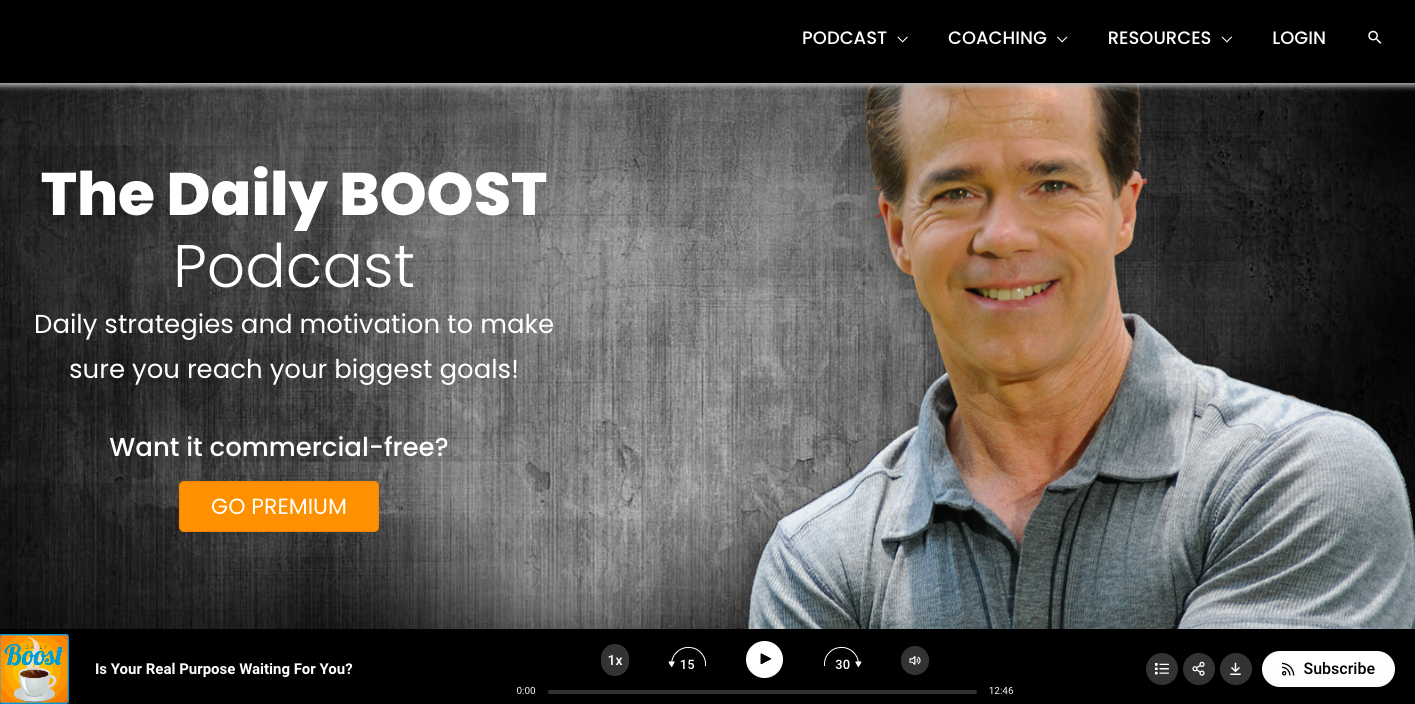
Many podcast hosting platforms include website options - so it needn't cost you much extra money. Here's a guide on creating a top site.
#14 — Link your RSS feed to your website
Podcasts are recorded audio files that use RSS to get to their listeners. RSS stands for Really Simple Syndication (or Rich Site Summary). You upload your audio file to your podcast hosting provider, and they create the RSS feed (the link sent to the podcast directories.)
Your RSS feed should also be right there on your website. That way, every link from guests, social media platforms and people quoting your work leads back to your website. Embedding your RSS feed ensures that your website is a one-stop shop for everything linked to your podcast.
#15 — Transcribe the audio and add it to your website
People love to listen to podcasts, but some like to read your podcast episodes too. (They're also convenient for writers who want to locate a quote or piece of information and link to it in their article.)
Transcripts also give you more opportunities to include keywords and search terms. That fills in another piece of the SEO puzzle, sending Google and other search engines straight to your website. Here's how to transcribe your podcast episodes for free.

#16 — Get backlinks from blogs and other podcasts
Backlinks are hyperlinks on other websites that connect back to your podcast website. They're another crucial element in your SEO strategy because when quality links point to your website, it signals to the Search Engine that you have a reputable and worthwhile site.
Getting backlinks from blogs used to be the go-to tactic, but podcast websites are super undervalued for their SEO benefits. You'll find all you need to know in our detailed article "How to Acquire Podcast Backlinks in 2022."
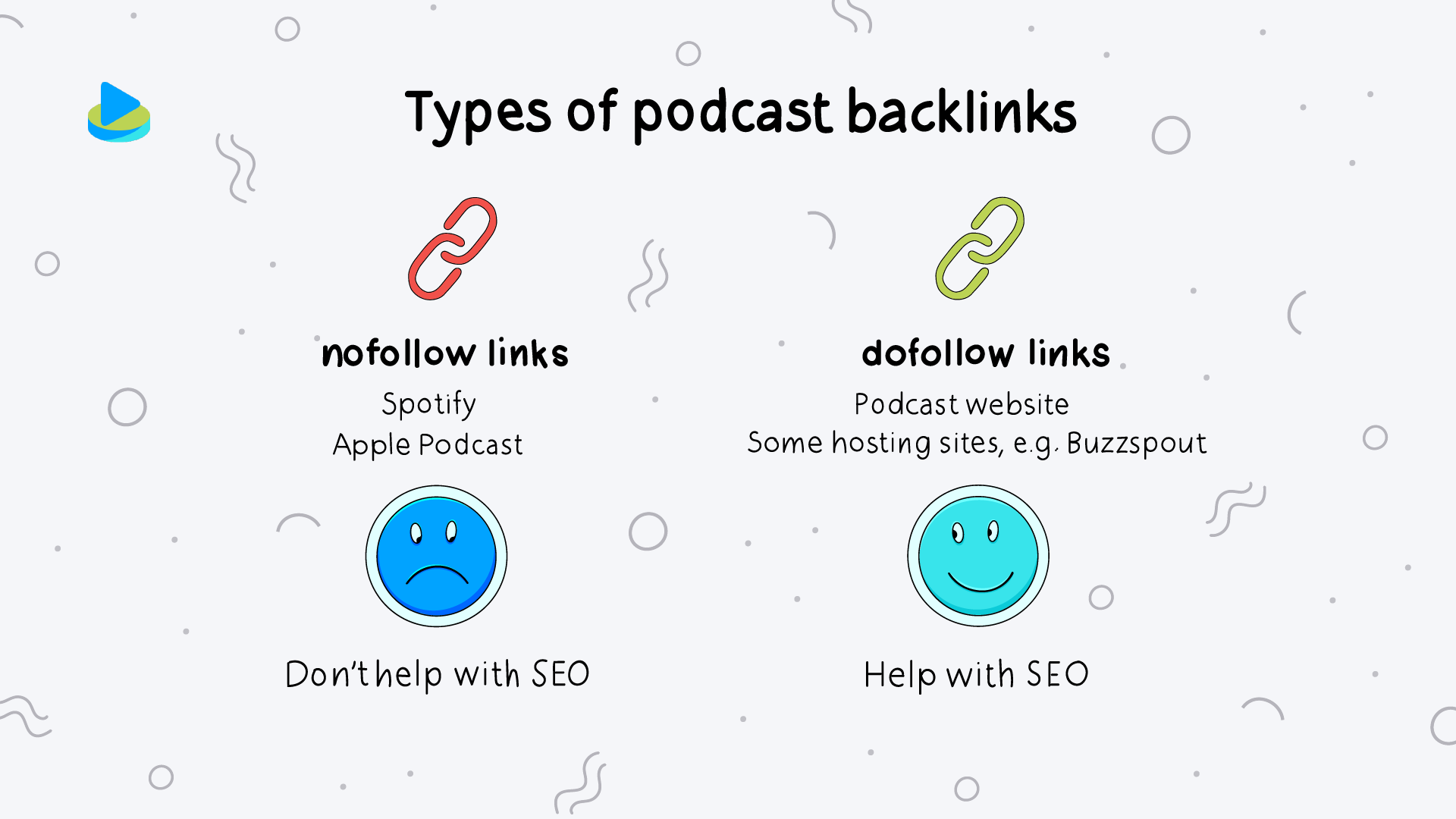
#17 — Backlink to the resources and people that you mention
Use your podcast show notes to link to any resources or people you mention in your podcast episodes. And, of course, let them know about it so they can return the favor. Many newsletters give shout-outs and links to people who've genuinely promoted them in podcasts and other content formats.
You'll often see a 'links' or 'resources' section on the podcast's website for each episode. Here's how Amy Porterfield links to resources she mentions.
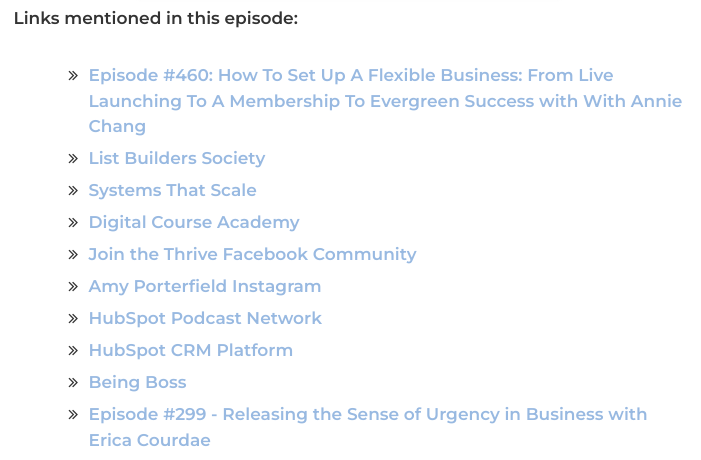
#18 — Display your reviews on your website
Displaying all the nice things people say about your show goes a long way to attracting new listeners, guests and sponsors. It also helps wih SEO.
Many top podcasts do it. But they have a team to help them create a dedicated section on their website and continually update it with the latest reviews. Chances are, you don't have the time or resources to do this.

Rephonic has created a free tool so you can easily display your latest reviews on your website in a few clicks. Here's how to do it so they show like this:
Promote within your podcast episodes
#19 — Hook listeners in the first 10 seconds
The first ten seconds can make or break your podcast episode. Think about it. How often have you read the first paragraph of a book and put it back on the shelf because it didn't capture your attention? How often do you leave YouTube videos during their tedious intro? Don't let your podcast fall into that trap.
Some podcasters tease the episode with an unexpected, funny or valuable snippet from the interview. Others explain the key points - an advance summary to show the episode's value.
The Business Collective asked their readers for the 12 best ways to hook your podcast listeners, and here are their recommendations.
#20 — Theme each episode or season of episodes
Create a series of episodes around a theme and make a big deal of it. Do extra podcast promotion on social media and your website, and talk about it in prior episodes.
One example is Unthinkable with Jay Acunzo. Here, Jay themed four episodes that focused on 'creating little pockets of resonance rather than making a big splash' and called it MINI-Series.
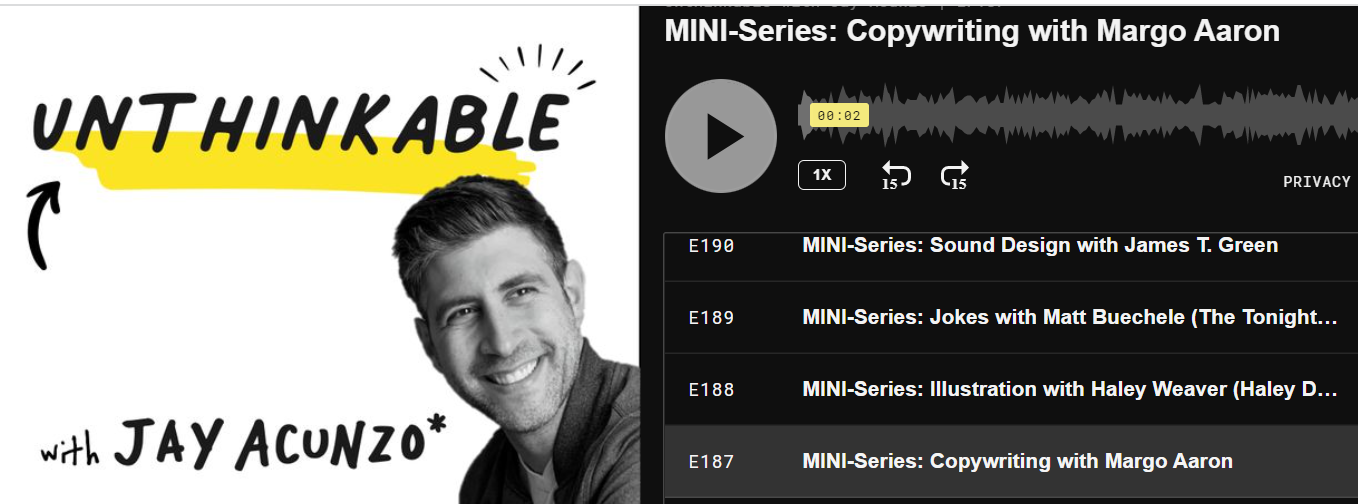
#21 — Mention other relevant episode titles
When planning new episodes look back over your back catalog to see what content might provide further information on that topic. Mention one or more of those episodes, say why they're valuable and provide a link in the show notes.
This tip is especially relevant to teaching and "how to" podcasts, but it can work with any genre. It boosts your download numbers and gives people direction when they want more information.
You can see in this episode transcript for Let's Talk About Mental Health that the host refers back to old episodes that listeners might find interesting.
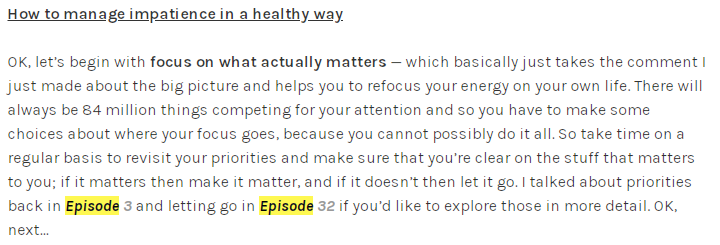
#22 — Publish one episode a day for 30 days
When Steph Smith and Calvin Rosser wanted to test their podcasting mettle, they recorded and published one daily episode for a whole month. This challenge was an excellent test of their podcasting stamina and resolve. But it also had another unexpected benefit.
Those 30 episodes weren't the best they've ever recorded, but they took the "Sh*t You Don't Learn in School" listeners on the journey too. Starting from zero, they gathered a two hundred-strong strong audience who begged them to continue the podcast at the end of the 30-day trial.
#23 — Ask people to subscribe and leave a review
Don't be shy about asking people to like, subscribe, rate and review your podcast. Yes, you'll get some duds. But if you're doing a good job, you'll get many more positive reviews than one-star ones.
Ratings and reviews don't affect searchability but provide social proof that people enjoy your podcast. Many podcast hosts ask people to rate and leave a review on Apple Podcasts in every episode. That podcast directory is the obvious place to send them, but don't neglect other options. Put the call out on social media, and mention it on your website and your blog. Consider using Rate This Podcast* to make a memorable link.
* Disclaimer: Rate This Podcast is another service owned and operated by Rephonic.
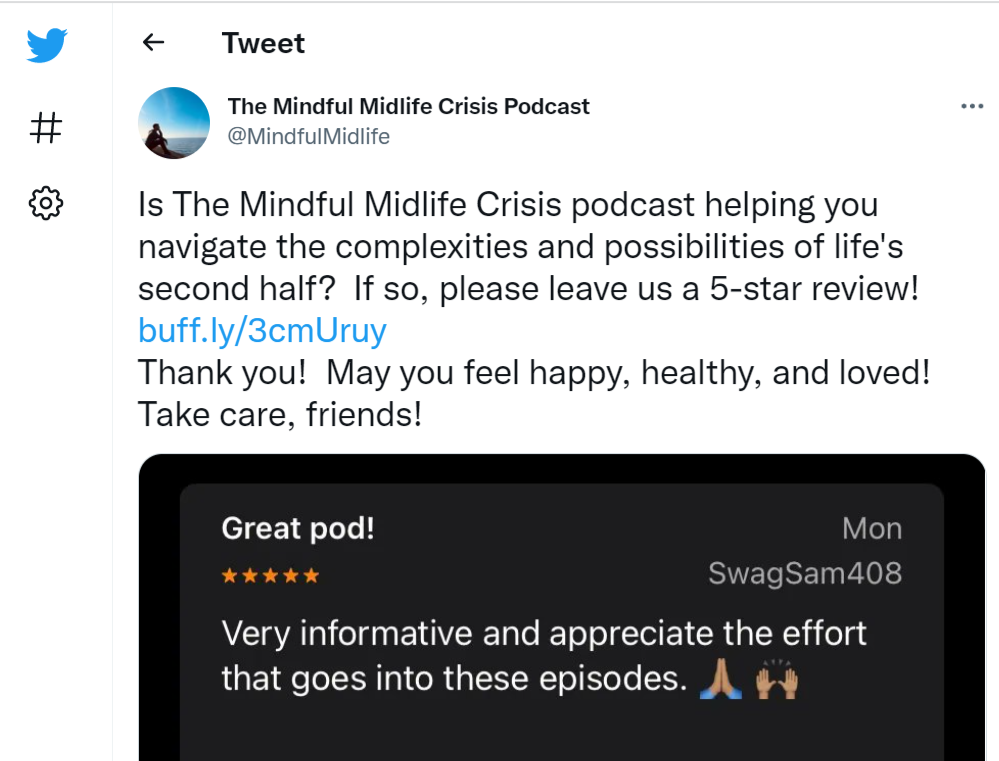
#24 — Ask listeners to share the episode with someone who needs it
If you've ever listened to Online Marketing with Amy Porterfield, you'll know how skillfully Amy asks people to share the episode with someone who'll find it valuable.
Suggesting shares is an excellent tactic for increasing download numbers because it feels like you're helping your friend and doing a favor for a podcast you admire.
Here's an example from Online Marketing #480 (subject Time Blocking):
All right, my friends. Thanks so much for hanging out with me. And if you'd be so kind, will you please share this episode with a friend? If you know you've got a friend who loves to plan things out, is looking to get more organized and streamlined, maybe they'll love this episode.
#25 — Give shout-outs to listeners who leave reviews
Publicly acknowledging reviewers' efforts can be a positive way to encourage listeners to leave glowing reviews. You can easily create a 30-second slot in your regular schedule to mention a reviewer's name, thank them and read out what they wrote.
Giving shout-outs has the double advantage of encouraging reviews and showing everyone your listeners' high regard for you and your podcast episodes.
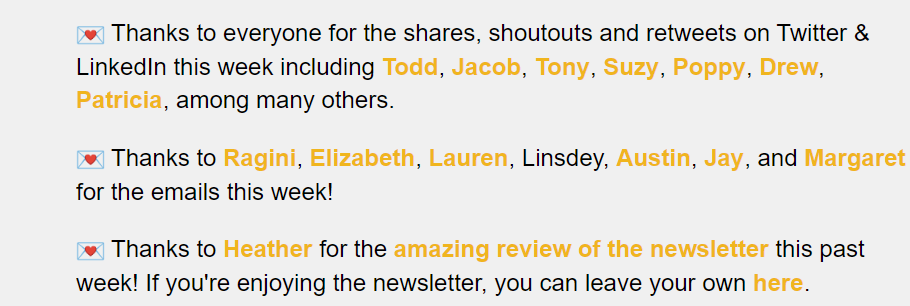
#26 — Involve your audience with an "audience segment"
Get your podcast audience on board by regularly including an audience segment. If you're a podcast listener, some of your favorites are probably already springing to mind. Shout-outs are a small way to get started, but many podcasts make a feature of audience involvement.
Grammar Girl, Mignon Fogarty, has a "Familect segment where listeners send in voice messages explaining an unusual (often made-up) word only their family uses. And The Curious Cases of Rutherford and Fry has "Curio of the Week," where fans send in artwork, songs, memes etc., for the chance to win the podcast's coveted Curio award.
By the Book, where the hosts live by the advice of self-help books and share their experiences, takes audience involvement even further. In that podcast, every second episode is entirely based on listener feedback and reactions to the previous episode.
Promote on social media platforms
#27 — Choose new social channels wisely
Just as you can't be all things to all people, you can't realistically be everywhere on social media. So, the best podcast promotion tactic is to create a social media presence where your target audience hangs out.
Younger audiences tend to go for Snapchat, TikTok and Instagram. It makes sense for a Business or Leadership podcast to cultivate an audience on LinkedIn or Twitter. However, a teaching or how-to podcast which also publishes a blog post with each episode might do well on Pinterest, Facebook or Instagram.
Wondering which might work best for you? Check out the top ten social media sites according to the Search Engine Journal. We also did some research on podcast social media channels that you might find useful.
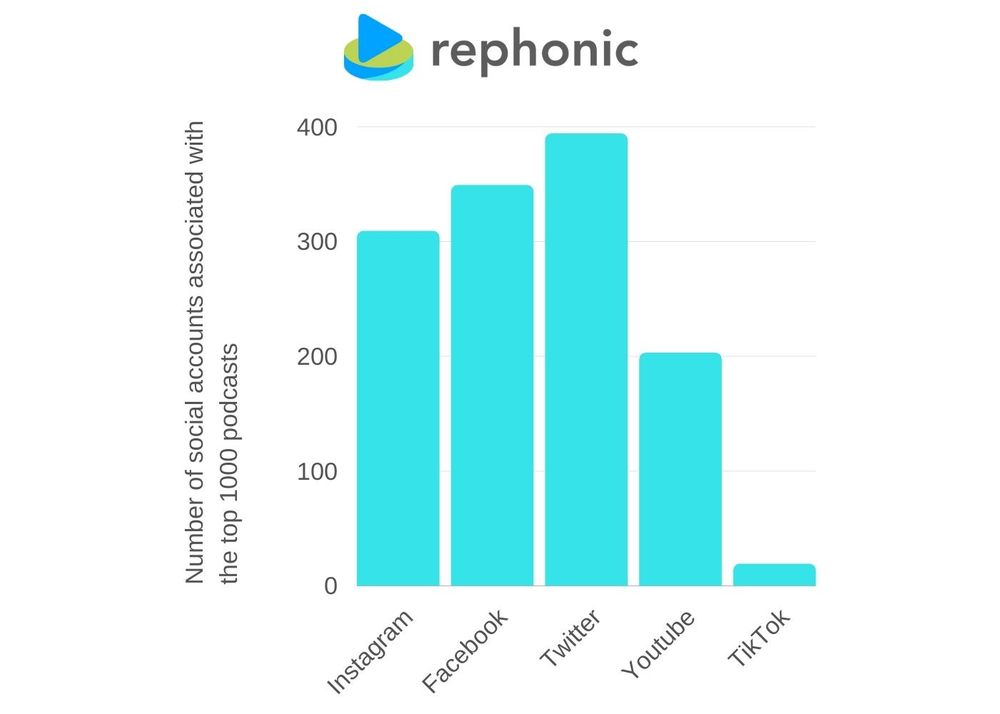
#28 — Add a link on your personal social accounts
Like email signatures, your social media accounts are free advertising space. People who know you have your own podcast will expect to see a link there. And if people search for your name, your social channels may appear. So, having a link and maybe even a podcast description on your public page makes sense.
The Social Media Hat blog has interesting, easy-to-read articles if you're looking for more ideas on how to use a social media platform for marketing.
#29 — Use hashtags
Hashtags # are used on social media to help users find content and conversations grouped around a specific topic. This blog post from Hootsuite gives an excellent breakdown of why, when and how to use hashtags to your podcast's advantage.
#30 — Ask friends, family and colleagues to share your podcast on social media
Don't underestimate your network. Not everyone will be interested, but you might be amazed how many will be totally on board with your new podcast venture. Ask everyone you know to share your episodes as they come out (even if they don't listen to them.) It's even better if they do because they can genuinely say how great it is.
#31 — Engage your social audience before posting an episode link
Get the conversation going in a way that invites comments and shares, THEN link the episode title in the comments. Steph Smith talks about how she used that tactic in her conversation with Courtland Allen on Indie Hackers (episode 246).
"What I found worked really well on Twitter... was tweeting about the topic that I was going to write about first. (This is a vetting mechanism (too)… Is this something people are interested in?) And then letting that tweet blow up.
E.g., Steph's Tweet about the 40-hour work week generated 9K likes and 122 replies. With that conversation underway, she appended another Tweet about the podcast episode she'd just recorded about the topic which brought in 1000 downloads.
#32 — Create graphics of guest quotes for social media
Pique interest in new podcast episodes by creating graphics of meaningful or controversial quotes from that week's guest. Pair them with images that suggest the episode theme or use the guest's photo. Don't forget to include the episode title and a link.
There are many different platforms to help you make eye-catching graphics: Adobe Creative Cloud, Veed, Creator Studio and Canva to name a few. Here's a helpful video from Canva on how to design graphics to promote your podcast.

#33 — Use visual soundbites for social media
Instead of a written quote, you can pull a short, punchy clip from your podcast episode and post it on Instagram, Twitter or Facebook. We mentioned a Canva example in tip #31, and you can make audiograms using Canva, too. However, Pod School has an informative tutorial using a combination of apps to make a real splash with your audio animations.
#34 — Post more than one snippet per episode on social media
From scrolling through your social media feed, you know that most posts are here now and gone an hour later (make that five minutes later on some channels.) So, create more than one social media graphic per episode and share them all more than once.
Sharing so much can quickly get overwhelming, so consider hiring an SM manager or VA or signing up to websites like Co-Schedule, Zapier, or Tailwind. Check out this article for more information on automation.
#35 — Create a guest promotion kit
Everyone asks their interview guests to promote their episode on their social media channels, and it absolutely makes sense for them to do that. They have a vested interest in getting ears on their episode too. However, you can make it easy for them to do a fantastic job of helping you promote your podcast by creating a promotion kit.
Once you've made a template, it's easy to copy and paste a guest's episode details into it and include the kit with your thank you note. Include a shareable social media post, graphic, Twitter quote, suggested note for their email newsletter, and the all-important episode link.
Create community
#36 — Create a community on Facebook/WhatsApp/Telegram/Discord
Some podcasts get terrific community engagement when they provide a place for their existing audience to meet online. Facebook is one of the most common community platforms, and it's easy to set up a group. Telegram has a strong base in the Cryptocurrency community, so it might be a good option if your podcast covers Web3 matters. Discord is aimed squarely at the gaming community, so it's perfect for Gaming podcasts. Even WhatsApp seems to be bringing in a Communities option, which could be a place for groups in the future.
#37 — Engage with comments and DMs
Social media thrives on engagement. So if your listeners take the time to comment, it makes good sense to reply. It's easy to be hands-on with a small group, but larger groups have social media managers or admins who often take on that task. Here are some practical ideas from Social Media Examiner to help you engage with people on Instagram.
#38 — Do some live streams
Live streaming software lets you send a video podcast out unedited in real time. It's available through most social medias platforms including Facebook, Instagram, Twitch and YouTube and through hosting companies. Here's a comprehensive guide to live streaming from Vimeo.
#39 — Create an email list
When you rely on social media marketing, you place your faith in platforms that don't belong to you. One significant algorithm change could see a large chunk of your audience disappear overnight. That's happened to many bloggers and YouTubers in the past. That's why cultivating your email list is a must-have part of a podcast promotion strategy.
You've probably heard of Mailchimp, Convert Kit and other email marketing companies that help you collect and store email addresses and create and send newsletters and campaigns. Here's a helpful podcast email marketing guide from Mailerlite to get you started.
#40 — Write a regular newsletter
Communicate with your email list by sending a weekly or fortnightly newsletter. Some podcasters have short and sweet newsletters that simply alert people to their upcoming episodes. But you could also give behind-the-scenes glimpses, include a link to an accompanying blog post, promote merch and live shows and tease future episodes or events.
#41 — Create challenges and invite shares
There's nothing like a listener challenge to engage your current audience and attract new listeners, too. The Problogger Podcast frequently used this strategy successfully during their 280-odd episodes.
Some of the best challenge examples are Darren Rowse's 7-day content sprints. Darren would discuss a content form (e.g., Evergreen Content or Listicles) and challenge his blogger audience to write something using that form on their blog and share it with the Problogger Facebook community. Listeners hung on every word and relished the chance to share links to their work with such a large group.
Network in the industry
#42 — Connect with other podcast hosts and influencers
Take every opportunity to learn from and connect with other podcast hosts and influencers. If you still have small download numbers, try to communicate with Nano or Micro influencers around your size or slightly larger because they're still working at a personal level. It's harder to leverage influencer marketing with Mega influencers, who usually have gatekeepers to protect their time.
#43 — Collaborate with other podcasters
Podcast collaboration is a win-win way for hosts with related audiences to get more ears listening to their podcasts.
The easiest way to find shows with a similar audience is via Rephonic's free 3D graph tool. Just type in the name of your show to see a web of podcast connections.
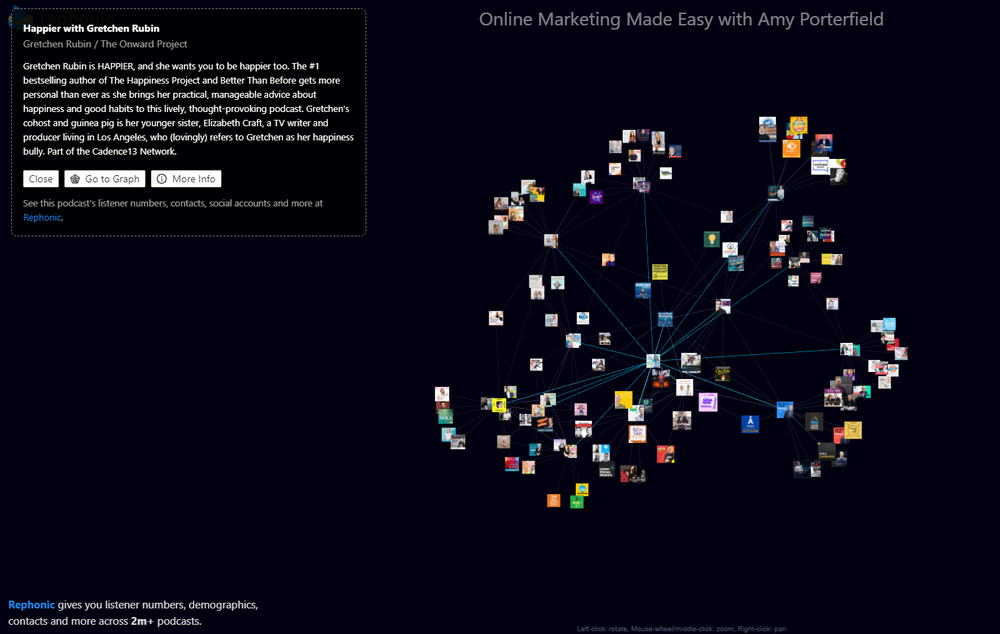
There are many types of collab you could opt for, including shout-outs, ad swaps, and guest interviews. Check out our full guide or video on how to collaborate with other podcasters for more tips.
#44 — Like the social content of people who listen to shows similar to yours
Brands use social listening to discover and respond to what people are saying about them on social media. You can use a similar strategy to find and respond to people talking about other podcasters in your niche. Keep it clean and respectful so that your likes and comments enhance the conversation. That helps to get you on the podcaster's radar and may encourage their listeners to sample your podcast too.
#45 — Join HARO (Help a Reporter Out)
Investigative and feature journalists must find reputable sources for their articles. HARO is a website that connects writers who need information with the experts who can provide it. If you host an authoritative podcast, HARO is a great way to get your name and expert reputation in front of a different audience.
#46 — Create a media kit
A podcast media kit contains essential information about your podcast, including host descriptions, listener numbers, social data sponsorship opportunities and so on. Creating a kit with all this information in one place makes it easier for podcast hosts to connect with journalists and sponsors.
We've created a free template with step-by-step instructions on tailoring it to your podcast.
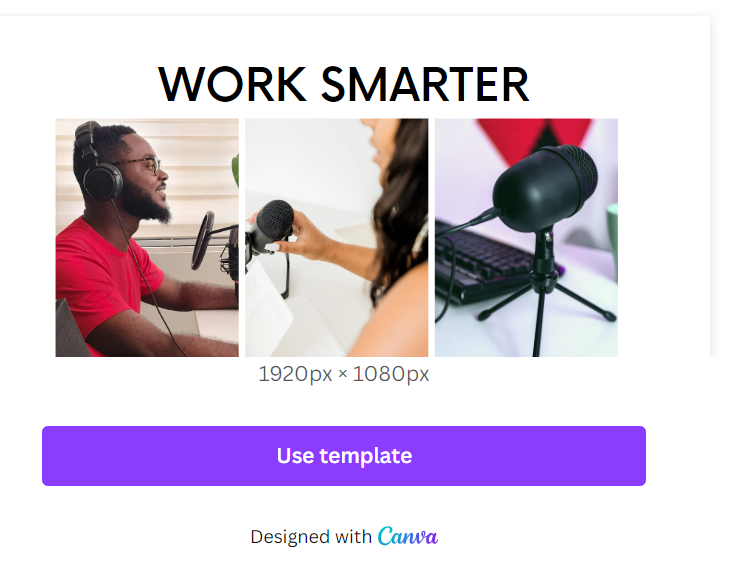
#47 — Add to the conversation
When you find a suitable conversation on platforms like Twitter, LinkedIn, Reddit or Quora, try adding helpful or insightful comments on discussions related to your podcast in general or particular episodes. Comment to enhance the conversation with examples rather than overtly promoting your podcast.
#48 — Send out press releases
Journalists are busy people who appreciate a heads-up, but only if your news is worth spreading. So, if something fabulous is happening on your podcast, let relevant journos and publications in your industry or niche know by sending a simple, well-written statement that writers can use verbatim if they wish. Even better, send them an image they can use with their article, too.
#49 — Reach out to industry newsletters like Podnews
Industry newsletters like Podnews are excellent places to find out about happenings in the podcasting world. Try a few and subscribe to the ones you find most useful. You'll learn about events, upcoming podcasts, changes in Apple and Spotify and more. Send your press release to one or more relevant newsletters as another way to spread the word in your industry.
#50 — Network at conferences and shows
Some people cringe at the word network, but at its heart, podcast networking is about making connections that can be mutually beneficial down the line. It's worthwhile attending industry events in your niche, and it's also great to connect with other podcasters at podcast industry events. Be brave. It gets easier with practice.
Use multiple platforms
#51 — Video your episodes
Audio has many benefits. You can listen on the go. And hearing the host's voice makes it feel very personal to a listener. However, more and more podcasters are recording their interviews on video. Having a video opens new possibilities for those social media marketing clips and entices those audiences who prefer a visual medium.
#52 — Publish your episodes on YouTube
There are many ways to put your episodes on YouTube and we detail them in this article. Another idea is to create engaging clips and post them as short videos. The CreatorSmarts Podcast is a good example, uploading several punchy clips from each new episode to their YouTube channel.
Searches for 'podcasts' on YouTube have soared since Covid hit so it's worth keeping up with the trend.

#53 — Consider getting on TikTok
75% of TikTok users are between the ages of 18-34, which makes it a fantastic place to attract a younger audience.
TikTok isn't the place to share an entire podcast episode. Instead, use it to generate leads (people going to your podcast episodes.)
Share short, punchy clips around your podcast's overall theme or an episode topic - see this example from Warden's Watch. Make sneak peeks of upcoming episode titles and content; use music & video on TikTok - it's all about capturing attention.
Check out these seven tips for promoting a podcast on TikTok and our own analysis of what podcasters are doing on social media.
#54 — Advertise in newsletters
We mentioned reaching out to podcasting newsletters like PodNews, but it's also worth testing paid shout-outs in newsletters that your target audience likes to read.
For example, if your show is about bodyweight exercises, you could sponsor a newsletter like Simply Fit Society and get your show in front of its 16,000 subscribers.
A quick Google search for your topic with throw up some opportunities.
Get creative
#55 — Run giveaways
Everyone loves to win, so promoting a podcast with contests can be a fun way to raise awareness or attract new subscribers. According to this article from Gleam, you need different types of giveaways depending on what you want to achieve with them. This article from Short Stack walks you through the steps for using a contest to get reviews.
#56 — Produce merchandise
Selling products can be another way to attract an audience, although themed merchandise is more likely to appeal to people who are already fans of your podcast. You can also use your merch as prizes in your contests and giveaways. Some podcasts sell standard coffee mugs, t-shirts etc., but there is a world of possibilities for products related to your overall theme or niche. Spring and Pietra are two SaaS companies leaping forward to help you be more innovative.
#57 — Create podcast playlists
Amy Porterfield recently hit a million downloads in one month and shared her promotion tactics in episode #462. One of the most successful tactics involved creating a quiz that sent people to playlists based on their answers.
"We created a quiz that made a curated playlist for listeners. We used Interact to make the quiz, created a landing page for the quiz and directed listeners to podcasts that would best help them using a PDF. "
Final words
You can't start implementing all these tactics immediately, nor should you even try. Advertising your podcast takes time, planning and effort. So, here's how to start your podcast promotion.
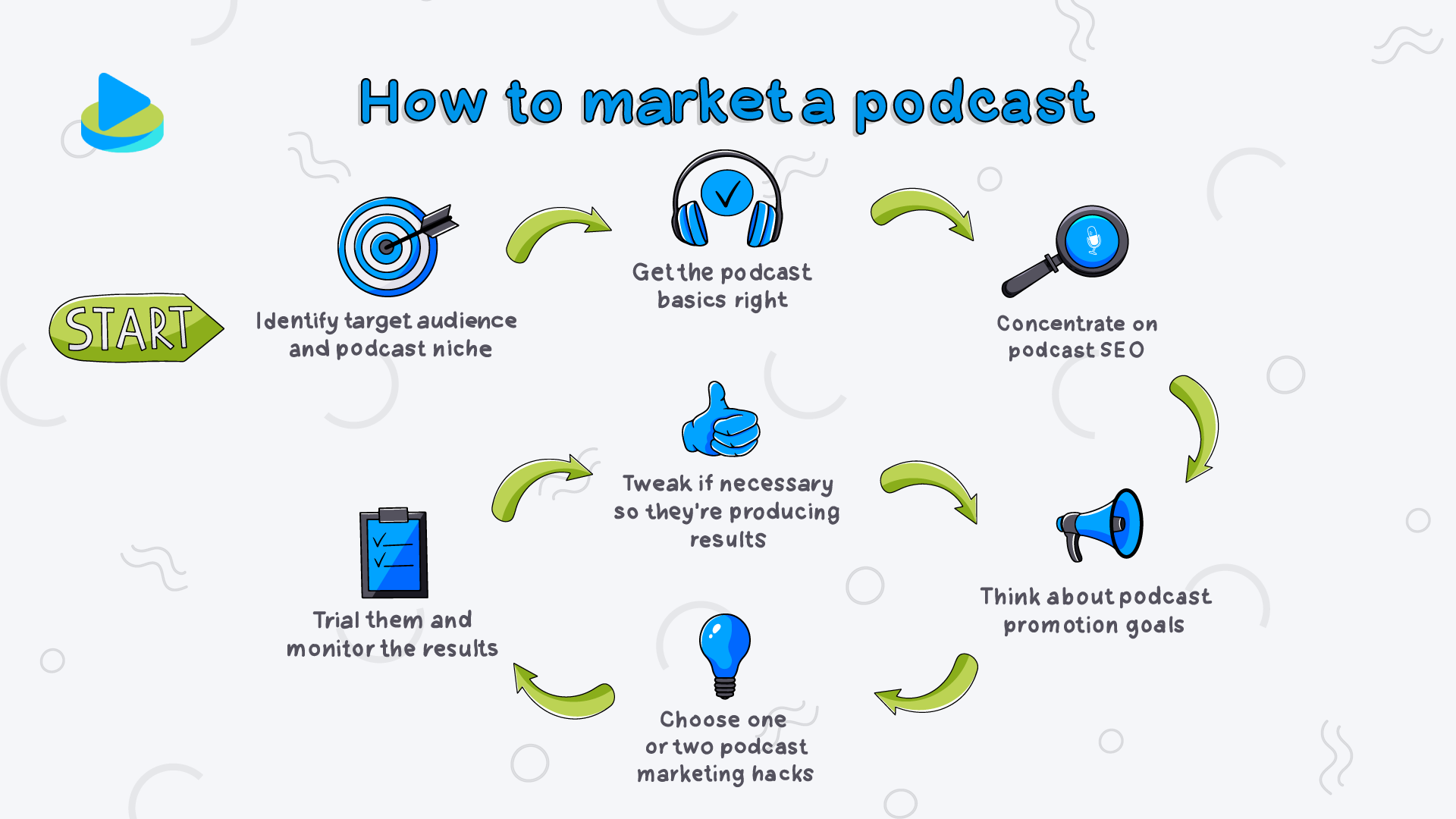
Keep creating top quality podcast episodes and developing your marketing strategy and it won't be long until you get your first (or next) 1000 subscribers.
Rephonic is a database of over two million podcasts that helps brands find the right shows to reach out to as a potential guest or sponsor. Claim your podcast now to ensure they're seeing the best data.

